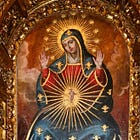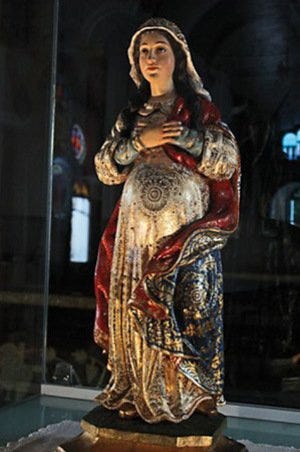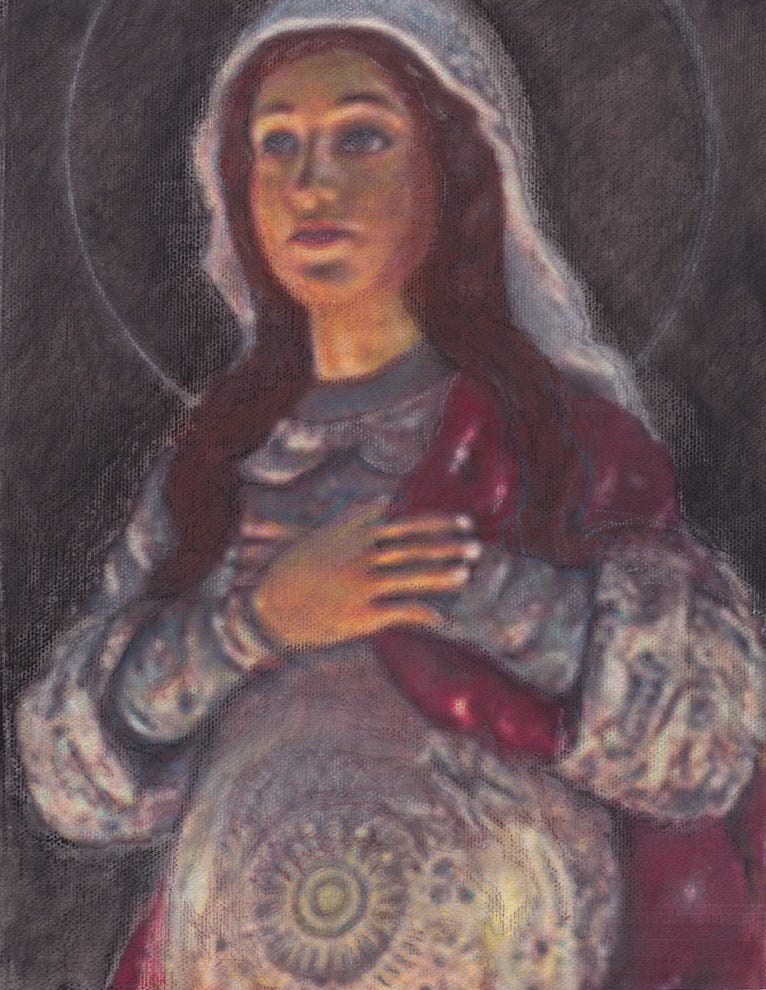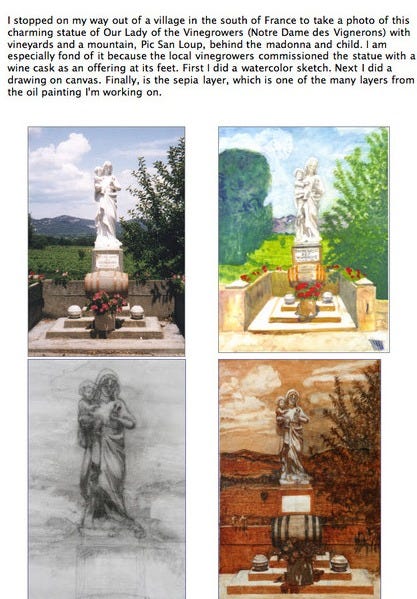This Sunday! Second Annual "Very Marian Prayer Service," December 15, 4-5:30 PM PST. Plus, more information about my Advent Carol, Marian poetry, and art
"Our Lady Expectant," An Advent Carol based on a poem by me, will be performed again this year, with other new and old sacred music for Advent! Sign up for a link to a recording.
Celebrating Advent with Mary, Music, and Prayer
A Very Marian Advent Prayer Service
Sunday, December 15, 4 - 5:30 PM PST
Star of the Sea Church
4420 Geary Boulevard
San Francisco 94118
A reception follows.
Registration is not required, but it helps to plan the reception. A registration option is available to request a link to the recording that will be made of the event. Register here.

Offering an alternative to the secular “holiday music” dinned in our ears during the months before Christmas—firmly in the spirit of not celebrating Christmas before its time—on December 15, Archbishop Salvatore Cordileone will lead the Second Annual “Very Marian Prayer Service” at Star of the Sea Church in San Francisco.
Those who attend or sign up to get a link to the recording afterward will hear beautiful Advent music, both ancient and new.
This year, Archbishop Cordileone’s Benedict XVI Institute for Sacred Music and Divine Worship continued its mission to bring new sacred music of the highest quality into the culture by commissioning two new Advent Carols that will premier at the service.
The music will be sung by a 8-voice schola led by Timothy McDonnell, lately of Catholic University now the music director of Hillsdale college.
Popular author Fr. Dwight Longenecker collaborated with the young Catholic composer William J. Fritz on one of the new pieces that will premiere that night, "Our Lady's Lullaby.”
Frank La Rocca, the Benedict XVI institute’s composer in residence and James Mathew Wilson, poet in residence, created the second new piece, "While All the Earth in Darkness Sleeps" a new setting of the 6th century Akathist Hymn (which recites the titles of Our Lady as the Theotokos, the Mother of God).
Two hymns commissioned for last year's Very Marian Advent Prayer Service will be sung again. "Chesterton's Carol" set to music by Mark Nowakowski, and "Our Lady Expectant,” which, as I’ve mentioned was based on a poem by me and set to music by rising young composer Wilhelmina (Mina) Pariseau.
The music for Our Lady Expectant is available for liturgical use for free here:
For public performances, contact the composer at https://minapariseau.com/contact.
Happy Advent News from Composer Mina and Her Husband Quinn
SCROLL DOWN FOR MORE ABOUT THE MUSIC AND THE EVENT
Mina and Quinn Pariseau were newly wed when she was commissioned to write Our Lady Expectant.

Here’s the good news from the Quinns:
Dear family and friends,
We are delighted to announce the birth of our son. He is a healthy, happy baby, born 6 pounds, 8 oz and 19.5 inches.
Love,
Mina & Quinn Pariseau
Genesis of the “Very Marian Advent Service”
For several years, Archbishop Salvatore Cordileone had been leading a musical event during the first part of Advent, when in 2019, the Benedict XVI institute organized a new type of St. Nicholas Day service that was reminiscent of the type of Anglican Lessons and Carols service broadcast each year by the BBC, but specifically Catholic. The music alternated with prayers and reflections led by Archbishop Cordileone.
I asked him: "What inspired you to create this seemingly unique service?"
He replied that the original idea for the service was based on the “St. Nicholas Day concert,” formerly held at the seminary on the first Friday in December. The the lessons and carols format suggested itself after the Benedict XVI Institute held a well-received Festival of Marian Hymns in May of 2019.
Last year, the location changed to Star of the Sea in San Francisco and the title changed to “A Very Marian Advent Service,” and the Benedict XVI Institute commissioned new Advent music to be included, including the setting of Chesterton’s Carol and Our Lady Expectant, the setting of a poem by me.
More About my Poem Set as an Advent Carol
In 2020, I wrote the poem “Love Song of Our Lady of O” for a Catholic Literary Arts competition, the first poetry competition I ever entered. It was the first poem I ever wrote on a religious topic.
The verses of the poem consist of Our Lady singing the O antiphons to the Baby Jesus in her womb during the last days of Advent.
What’s an antiphon? you might ask. An antiphon is a short line that precedes a liturgical hymn. The O antiphons got their name for the somewhat prosaic reason that each begins with an O.
Here is an excerpt from the article I wrote about the O antiphons and my use of them in the poem.
Each night between Dec. 17 and 23, wherever Latin Vespers or the vernacular Evening Prayer are prayed, one of the O antiphons is sung or recited before and after the Magnificat. In the post-Vatican II form of the Mass, each of the O antiphons is also included as the Gospel Acclamation during the Mass of the day.
Each of the seven O antiphons starts with one of the names of a Scriptural type of the Messiah. He is the Wisdom of God, the Ruler of the House of Israel, the Root of Jesse, the Key of David, the Dawn, the King of the Nations, and God with us.
Each O antiphon calls out to the Savior to come and to show us the power that is associated with the particular Messianic name that the antiphon uses. For example, ‘O Wisdom, that proceedest from the mouth of the Most High, reaching from end to end mightily, and disposing all things sweetly! come and teach us the way of prudence.’
The O antiphons powerfully express the Church’s longing and awe at this time of heightened anticipation, while Advent is coming to a close and our celebration of the birth of Christ draws near.
The Magnificat, of course, is the canticle of Our Lady, which she sang under the inspiration of the Holy Ghost during her visit with her cousin Elizabeth soon after the Annunciation."—Excerpted from the article linked here:
Our Lady of O is even less well known even than the O antiphons. Traditionally, the Feast of the Expectation of the Blessed Virgin Mary was celebrated on December 18 in many countries and by some religious orders as another occasion during the waning days of Advent to ponder Our Lady’s expectation of her Son’s immanent birth. Another O Antiphon, O Virgo Virginum (Oh Virgin of Virgins), is sung. It still is observed in some places.
The feast is often called Santa Maria de la O, or Our Lady of O, even in the liturgical books. The 1909 Catholic Encyclopedia states that the Feast of the Expectation of the Blessed Virgin Mary was celebrated “on 18 December by nearly the entire Latin Church,” and that the name “Our Lady of O” stems from the custom of clerics in the choir after Vespers on that day to utter a loud and protracted “O,” expressing the longing of the universe for the coming of the Redeemer.
Fr. James Geoghehan, O.C.D., former editor of Carmelite Digest, corroborated for me that the feast was still observed when he was a new Carmelite priest, when he emailed me this comment:
“December 18 is the feast of Our Lady's Expectancy, the anniversary of my First Mass,” sixty-plus years ago.”
Back to the contest: I got an exciting call from Sarah Cortez, founder of Catholic Literary Arts, that my poem Love Song of Our Lady of O won an honorable mention in the 2020 Advent writing contest, she said it was “a wonderful wonderful poem.”
That was our first contact. Sarah and I are now good friends. I have nothing but admiration that the Catholic Literary Arts organization is doing to teach and encourage Catholic poets of all ages.
The following not-quite-a-poem tells about how my son reacted with his typical Eeyore attitude. When I told him how excited I was, he asked, "Did they try to sell you a time share?" But, you can read the rest of it here:
Good News About My Poem “Love Song of Our Lady of O’”
I just called my son and blurted
I got this exciting phone call.
A poem I wrote was one of the top five
Entries In a poetry contest!
Congratulations. I guess. But be careful.
Did they want your personal info?
No, no, it’s legit. I mean, I know the judge,
It’s a real literary arts organization. And
The director who called said it’s a wonderful,
Wonderful poem. Really, that’s what she said!
Did they try to sell you a time share?
Do you have to sign up for anything?
Stop trying to make me laugh!
They’ll have a livestream event where
The poets will read their winning poems.
They are going to give ME money.
I guess you called the wrong person.
I didn’t know you wrote poetry.
I wrote poetry in class as an undergrad
And when working on my M.A. in writing.
And lately I’ve started again, trying to practice
Theories of a poet I’ve been interviewing,
Why poetry is better metered than howled.
Something I too thought perhaps makes sense
Ever since I first learned that even Baudelaire agreed
Metrical limits do not inhibit, but contrary-wise can set us free.
Just like the Commandments
Come to think of it.
Not that Baudelaire would likely agree with that.
Since he wrote a poem praying to Satan
That he might join him when he died.
Maggie Gallagher was the judge of the contest. The poem was subsequently published at Catholic Literary Arts and Catholic Arts Today.
Three years later, I was surprised and delighted that Maggie remembered the poem and suggested it when the institute decided to commission new music for the Advent and Christmas seasons.
It’s profoundly satisfying when an opportunity like that comes one’s way without one’s having done anything to seek it. Like a gift. Out of the blue. From above.
I’m also gratified that behind the scenes, in order to be part of this commission, my poem also must have gained the approval of Archbishop Salvatore J. Cordileone, founder of the institute and later when I ran into Frank La Rocca, the B16 institute’s composer in residence, he told me it is a fine poem.
Maggie wrote me at the time,
“You have written a beautiful poem, and I want to launch it into the liturgy of the Church. Down the road, I would like to record with our premiere choir and release a Christmas album.”
If her ambitious plans succeed in this case (and due to her intelligence, drive, and connections her far-reaching creative plans quite often bear great fruit), my poem set in this carol could conceivably become part of the permanent repertoire of songs Catholics sing every Advent. So far I have heard of it being sung in Florida as described here:
"I have a bit of good news for all of you who, like me, are excited by Archbishop Cordileone's Christmas/Advent Carol project. We commissioned two new hymns for our very first Very Marian Advent Prayer service. A young Catholic composer Mina Pariseau set to music a poem written by our own Roseanne T. Sullivan (whom Dana Gioia calls "the unofficial historian of the Catholic Renaissance.") The poem which is called "The Love Song of Our Lady of O" won an honorable mention in a 2020 Advent sacred poetry contest sponsored by Catholic Literary Arts. The hymn is called "Our Lady Expectant." It's a lovely way to wait with Mary for the coming of baby Jesus.
“And now we're told the new carol by composer Mina Pariseau Our Lady Expectant' is being used in a September 20 concert "Ever Ancient, Ever New II: Sacred Music from the Last Millenium," Kor Spiropoulos director at St. Patrick's Church in Gainsville Florida. Vespers at 6:40 pm, concert at 7:00 pm. . . . This is the second concert in the Ever Ancient, Ever New series, which brings together parish music directors, church singers, musicians, and composers from throughout North-Central Florida who are passionate about sacred music, celebrating its role in the life and liturgy of the Church, and spreading the joy of the faith through music."—Maggie Gallagher
No one has ever noticed that the title is reminiscent at least to me of a sadomasochistic 1954 French novel called The Story of O. My response to that thought echoing at least in my own mind is that the poem may help to reverse the decadent portrayal of womanly submission portrayed in that sleazy book. Our Lady’s submission and perfect obedience do not lead to her degradation as happens to O in the book.
Instead, she is exalted as the most perfect being ever born human. Mary is bodily with the Trinity in heaven, the first created being to inherit the promise of deification written about in the prologue to the Gospel of St. John. She is the greatest woman who ever lived, and she is like God in every way possible to a created being.
Art of Our Lady Expectant
When my poem was first published at Catholic Arts Today, we included this image of a statue that to me sweetly represents the late pregnancy of Our Lady. Its provenance is unknown.
I later did two of my own art works based on that statue, one in pencil and one in pastels. When Mina Pariseau prepared the score for Our Lady Expectant, she included my pencil drawing on the cover. The first page of the score is at the beginning of this article.
The pastel drawing is below. It was used in the December 3 Advent meditation by the editor of Catholic Artist Connection here.
Recently I became a bit surprised to notice how much of my art and poetry in the past few years has been about Our Lady. I now believe that she has been guiding me to not only write poetry, but also to create art honoring the events of her life.










